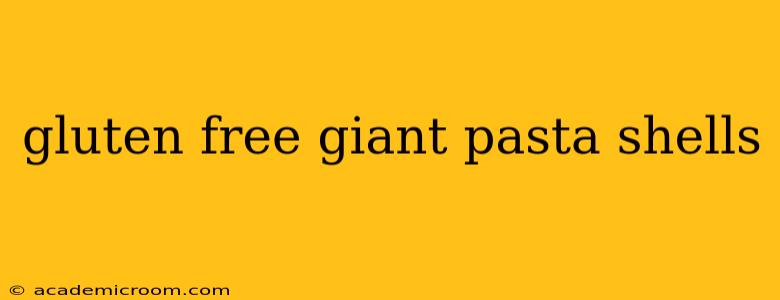Giant pasta shells, or jumbo shells, are a culinary delight, perfect for stuffing with creamy cheeses, vibrant vegetables, or hearty meat mixtures. But what if you're following a gluten-free diet? Fear not! This guide explores the world of gluten-free giant pasta shells, covering everything from finding them in stores to making your own from scratch.
Where Can I Buy Gluten-Free Giant Pasta Shells?
This is often the first question on many gluten-free cooks' minds. The availability of gluten-free jumbo shells varies depending on your location and the size of your local grocery store.
- Larger Grocery Stores: Major supermarket chains often carry a selection of gluten-free pasta, though the range of shapes and sizes can be limited. Check the pasta aisle, often near other gluten-free products. Look for brands specifically known for gluten-free options.
- Health Food Stores: Health food stores and specialty grocery stores dedicated to natural and organic foods are more likely to have a wider selection of gluten-free pasta, including giant shells.
- Online Retailers: If your local stores fall short, online retailers offer a vast selection of gluten-free pasta from various brands, often with convenient home delivery.
Tip: Always carefully check the packaging to confirm that the product is certified gluten-free and meets your dietary needs. Look for certifications from organizations like the Gluten Intolerance Group (GIG) in the US or similar organizations in your country.
What are Giant Pasta Shells Made Of?
Gluten-free giant pasta shells are typically made from a blend of gluten-free flours, such as:
- Rice Flour: A common and readily available option that provides a neutral flavor.
- Corn Flour: Another popular choice, contributing to a slightly sweeter taste.
- Potato Flour: Adds a smooth texture and can help bind the pasta.
- Tapioca Flour/Starch: Contributes to a slightly chewier texture.
- Lentil Flour: Offers a slightly earthy flavor and higher protein content.
- Chickpea Flour (Garbanzo Bean Flour): Adds a slightly nutty flavor and good protein.
The exact blend of flours varies depending on the brand and manufacturer. Some brands might also include xanthan gum or other binding agents to improve the texture and prevent the pasta from becoming crumbly.
Are Gluten-Free Giant Pasta Shells More Expensive?
Generally, yes, gluten-free pasta tends to be more expensive than its wheat-based counterpart. This is due to the higher cost of gluten-free flours and the often smaller production scale of gluten-free pasta manufacturers. However, prices are gradually becoming more competitive as demand increases.
How Do I Make Gluten-Free Giant Pasta Shells From Scratch?
While store-bought options are convenient, making your own gluten-free giant pasta shells allows for complete control over ingredients and ensures a fresh, flavorful product. Many recipes are available online; however, this requires specific equipment like a pasta maker and a significant time commitment.
Can I Substitute Other Gluten-Free Pasta Shapes for Giant Shells?
If you can't find gluten-free giant shells, you can substitute other large gluten-free pasta shapes, like large manicotti or even jumbo farfalle (bow ties), depending on your recipe. However, keep in mind that the shape may affect how well your filling stays inside.
What are the Nutritional Benefits of Gluten-Free Giant Pasta Shells?
The nutritional content of gluten-free giant pasta shells varies depending on the blend of flours used. However, some gluten-free flours are naturally rich in fiber and offer a good source of certain vitamins and minerals compared to traditional wheat pasta. Always check the nutritional information on the packaging for specific details.
By understanding the options available and considering the nuances of gluten-free pasta, you can confidently incorporate delicious and satisfying gluten-free giant pasta shells into your meals. Remember to always check labels and choose the best option that suits your taste and dietary needs.
